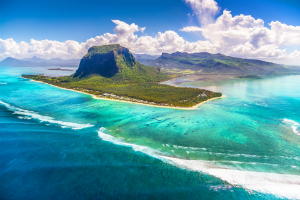We ask you, urgently: don't scroll past this
Dear readers, Catholic Online was de-platformed by Shopify for our pro-life beliefs. They shut down our Catholic Online, Catholic Online School, Prayer Candles, and Catholic Online Learning Resources essential faith tools serving over 1.4 million students and millions of families worldwide. Our founders, now in their 70's, just gave their entire life savings to protect this mission. But fewer than 2% of readers donate. If everyone gave just $5, the cost of a coffee, we could rebuild stronger and keep Catholic education free for all. Stand with us in faith. Thank you.Help Now >
Scientists unravel the story of a lost continent, hidden beneath the waters of the Indian Ocean
FREE Catholic Classes
According to science, Earth is very old. Our planet is a dynamic place, where the one constant thing is change. Without these dynamics, life could not exist, and Earth would be just as dead as Mars or Venus. These dynamics have shuffled entire continents around, so it should be no surprise that evidence of an ancient, lost continent has now been discovered.

Evidence for a lost continent was discovered on a beach on the island of Mauritius in 2013. We now know we know less than we thought we knew before.
Highlights
CALIFORNIA NETWORK (https://www.youtube.com/c/californianetwork)
2/9/2017 (8 years ago)
Published in Green
Keywords: lost continent, Gondwana, Mauritia, how, plate tectonics
LOS ANGELES, CA (California Network) -- First of all, it isn't Atlantis. The continent that scientists have discovered has a much less cool name, Gondwana (or, Gondwanaland). It's also super old, dating back to between 500 and 200 million years ago. The first multicellular life was developing when Gondwana was new. And when the continent broke apart, the most famous dinosaurs, which we all learn about as children, hadn't yet evolved.
Scientists have known about Gondwana for a long time, but it's the discovery of a microcontinent, a fragment of that larger landmass, which has them excited.
So, where was the continent, how much is left, and how do we know this is true?
Evidence for the continent has been found scattered across the Indian Ocean. The actual fragments of rock left over from the continent are spread between the islands of Mauritius and India. Some researchers are referring to the remaining fragments as "Mauritia."
About 60 million years ago, after the mass extinction of the dinosaurs, Mauritia broke away from India and Madagascar and spanned much of the space between the landmasses. It was eventually torn apart, and the fragments collapsed into the sea.
In 2013, Lewis Ashwal suggested a missing microcontinent could lie under the sea around the islands. His guess was prompted by the discovery of two-billion-year-old zircon crystals on the beaches of Mauritius.
Then, in 2015 another team of researchers examining volcanic rocks on the island found crystals that were 300 billion years old. The only rocks this old are found on continents, but Mauritius is an island in the middle of the Indian Ocean, and somewhat far from any continents. How did the fragments get there?
Researchers decided to look into the Earth and the surrounding sea floor for clues. They quickly discovered that Ashwal was correct.
Under the sea floor, rests ancient rock, three billion years old, which formed part of Gondwana. When Gondwana broke up, one of the last fragments to break apart was Mauritia. Then, nine million years ago, volcanoes erupted under the sea and pushed magma up though the sunken lost continent, bringing them to the surface as the island of Mauritius was formed.
What this discovery tells us is Earth's geology is less neat and clean than previously assumed. While we can roughly see how the continents once fit together, there may be many more pieces and fragments that we have never discovered.
Our knowledge of the Earth is extensive but imperfect. We can rest assured that we have solved only a fraction of the mysteries that encompass our planet.
Subscribe Now - Catholic Online YouTube
---
The California Network is the Next Wave in delivery of information and entertainment on pop culture, social trends, lifestyle, entertainment, news, politics and economics. We are hyper-focused on one audience, YOU, the connected generation. JOIN US AS WE REDEFINE AND REVOLUTIONIZE THE EVER-CHANGING MEDIA LANDSCAPE.
Join the Movement
When you sign up below, you don't just join an email list - you're joining an entire movement for Free world class Catholic education.
- Advent / Christmas
- 7 Morning Prayers
- Mysteries of the Rosary
- Litany of the Bl. Virgin Mary
- Popular Saints
- Popular Prayers
- Female Saints
- Saint Feast Days by Month
- Stations of the Cross
- St. Francis of Assisi
- St. Michael the Archangel
- The Apostles' Creed
- Unfailing Prayer to St. Anthony
- Pray the Rosary
![]()
Copyright 2025 Catholic Online. All materials contained on this site, whether written, audible or visual are the exclusive property of Catholic Online and are protected under U.S. and International copyright laws, © Copyright 2025 Catholic Online. Any unauthorized use, without prior written consent of Catholic Online is strictly forbidden and prohibited.
Catholic Online is a Project of Your Catholic Voice Foundation, a Not-for-Profit Corporation. Your Catholic Voice Foundation has been granted a recognition of tax exemption under Section 501(c)(3) of the Internal Revenue Code. Federal Tax Identification Number: 81-0596847. Your gift is tax-deductible as allowed by law.









